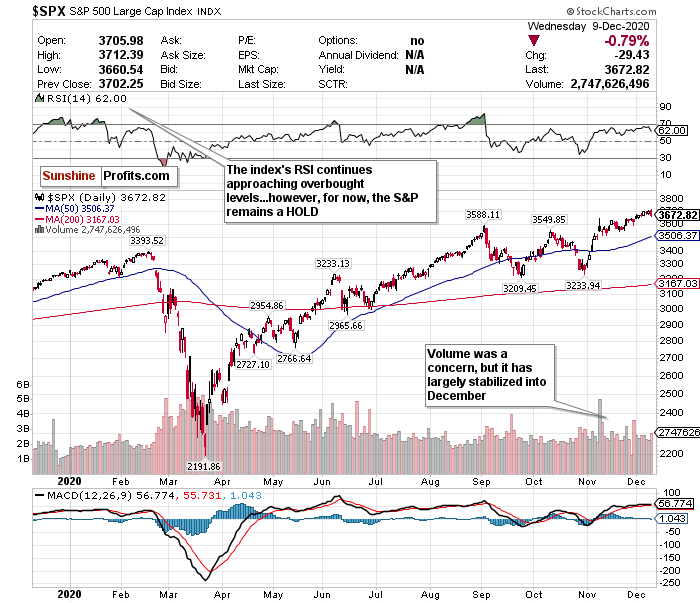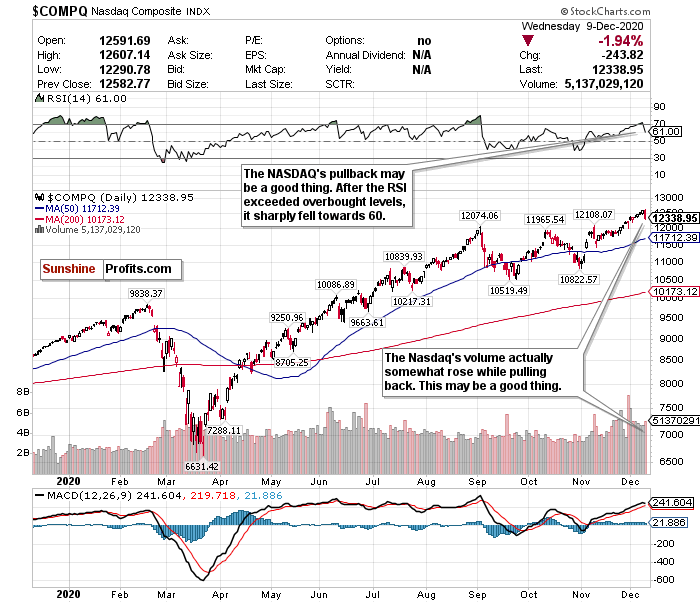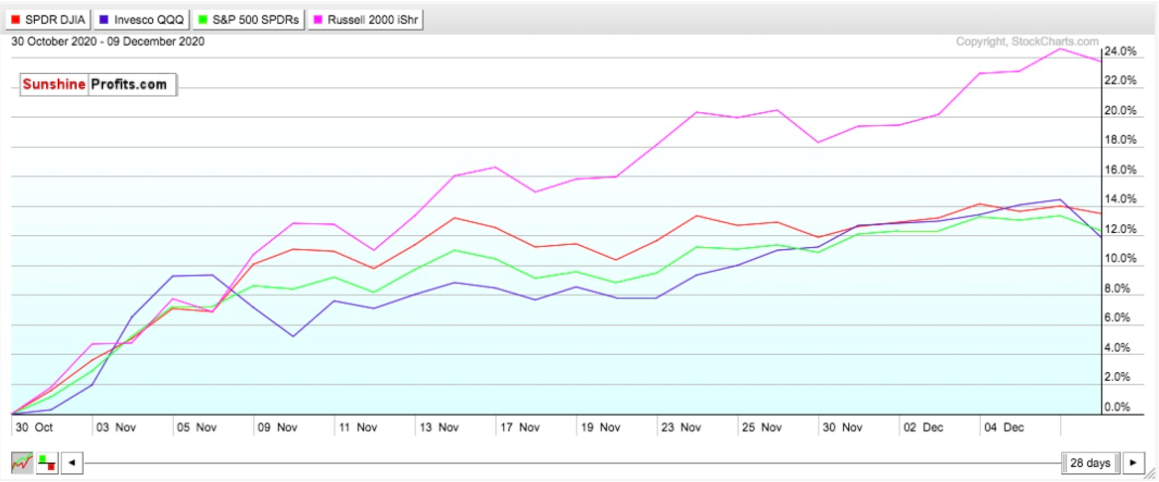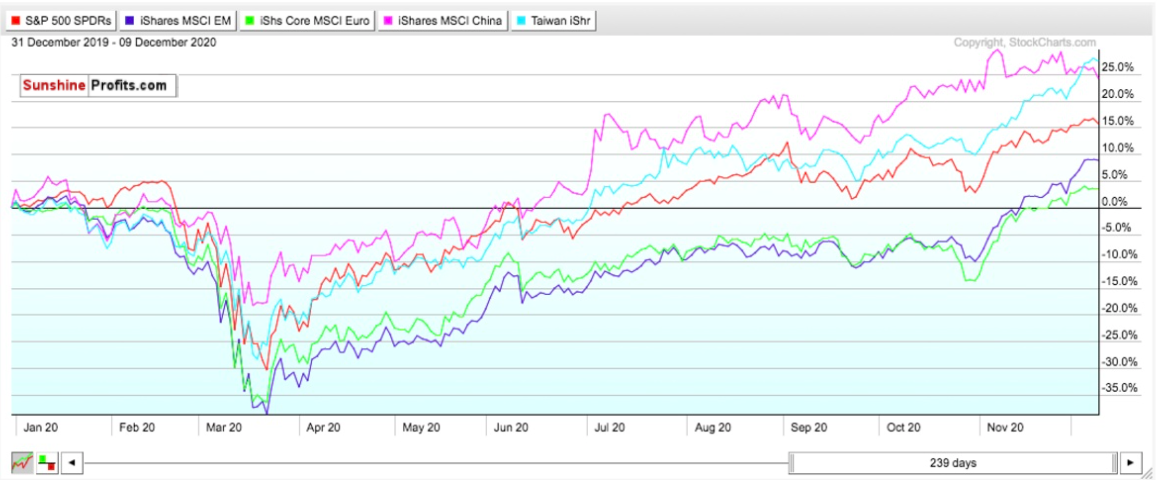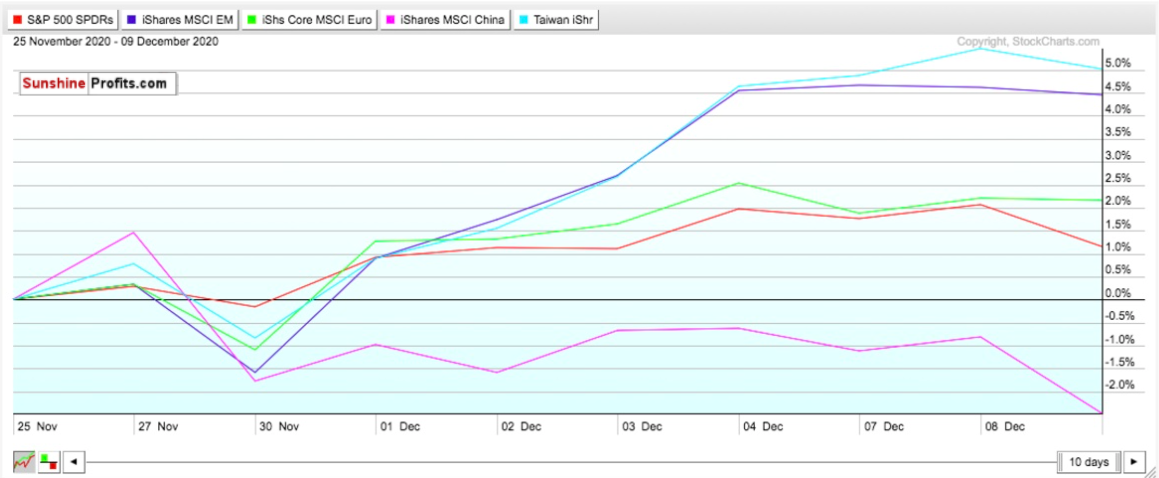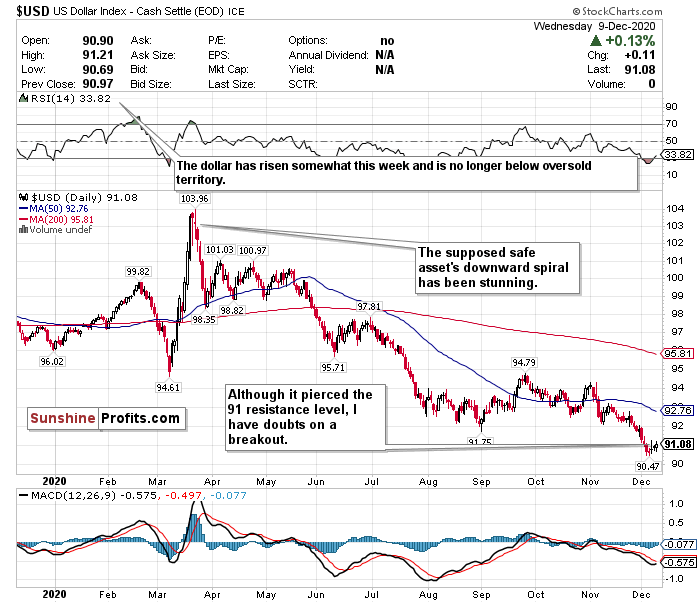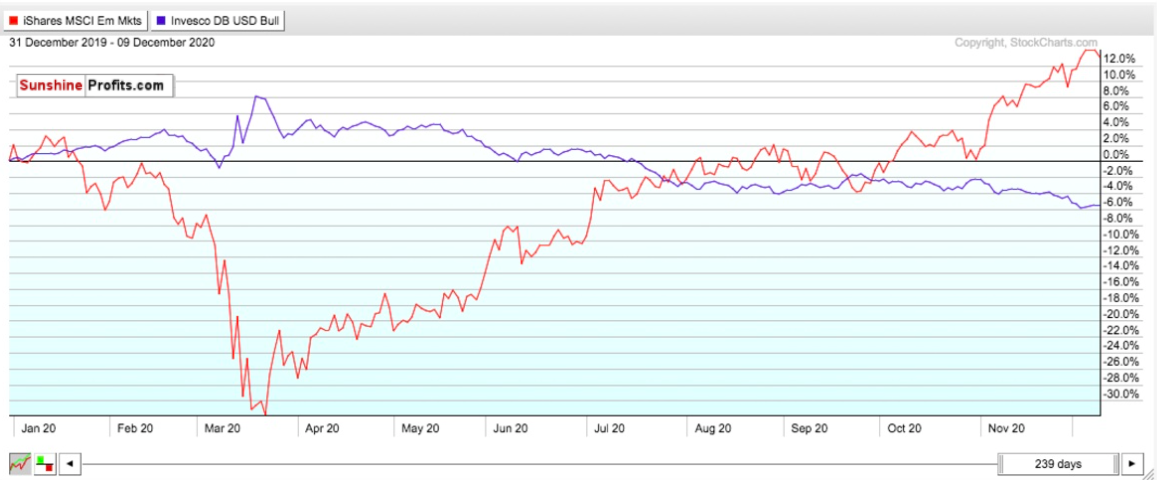After the market rose to intraday highs on Wednesday (Dec 9), the indices pulled back and closed in the red - largely led by the tech sector.
News Recap
- The Dow closed 105 points lower for a loss of 0.35%, the S&P 500 fell 0.8%, and the Nasdaq dropped 1.9% for its worst day since Oct. 30. The tech-heavy index also snapped a four-day winning streak. The small-cap Russell 2000 also fell by 0.82%.
- Wednesday was a resumption of the rotation out of tech that we saw in early November. Tech led the declines, and in particular, chip stocks such as Lam Research (LRCX) which fell by nearly 3.5%.
- Other big 2020 winners fell sharply on Wednesday as well such as Tesla (TSLA) which fell nearly 7% and Netflix (NFLX) which fell 3.72%.
- Stocks reversed downwards after Senate Majority Leader Mitch McConnell told Politico that Republicans and Democrats were “still looking for a way forward” on stimulus negotiations.
- COVID-19 continues to worsen in the U.S, but Tuesday’s rollout of Pfizer’s vaccine in the U.K., has spurred optimism. However, there are some concerns about people with a history of allergic reactions receiving the vaccine.
- Meanwhile, the Food and Drug Administration (FDA) may be just days away from approving Pfizer’s vaccine.
- COVID-19 continues surging to uncontrolled and grim levels. For the first time since the start of the pandemic, the U.S. hit 3,000 deaths in one day.
We may have reached a crossroads in the market between mixed short-term sentiment, and mid-term and long-term optimism. In the short-term, there will be some optimistic days where investors rotate into cyclicals and value stocks, and pessimistic days where investors rotate into tech and “stay-at-home” names. On other days, such as Wednesday, the markets may broadly decline, and be led by specific sectors. On Wednesday, for example, the leading laggard was tech - specifically high flying chip stocks.
In the mid-term and long-term, there is certainly a light at the end of the tunnel. Once this pandemic is finally brought under control and vaccines are mass deployed, volatility will stabilize, and optimism and relief will permeate the markets. Stocks especially dependent on a rapid recovery and reopening, such as small-caps, should thrive.
According to Ed Yardeni, president and chief investment strategist at Yardeni Research, “Renewed lockdown restrictions in response to the third wave of the pandemic are likely to weigh on the economy in coming months, but we don’t expect a double-dip…(but) the economy could be booming next spring if enough of us are inoculated against the virus.”
Other Wall Street strategists are bullish on 2021 as well. According to a JPMorgan note to clients released on Wednesday, a widely available vaccine will lift stocks to new highs in 2021.
JPMorgan’s S&P 500 target for 2021 is 4,400. This implies a nearly 20% gain from Wednesday’s closing price.
On the other hand, for the rest of 2020, and maybe early on into 2021, markets will wrestle with the negative reality on the ground and optimism for an economic rebound.
Additionally, since election week, the rally has invoked concerns of overheating with bad fundamentals. Commerce Street Capital CEO, Dory Wiley, advised caution in this overheated market. He pointed to 90% of stocks on the NYSE trading above their 200-day moving average as an indication that valuations might be stretched.
Amidst the current fears of a stall in economic recovery with further COVID-19-related shutdowns and no stimulus, it is very possible that short-term downside persists. However, if a stimulus deal passes before the end of the year, it could mean more market gains.
Due to this tug of war between sentiments, it is truly hard to say with conviction that another crash or bear market will come. If anything, the mixed sentiment will keep markets relatively sideways.
Therefore, to sum it up:
While there is long-term optimism, there is short-term pessimism. A short-term correction is very possible. But it is hard to say with conviction that a big correction will happen.
The S&P Has Long-term Upside…But a Blurry Short-term
As briefed in the news update, some analysts believe the S&P could have up to a 20% upside in 2021, while others caution against an overheating index. According to another survey of market strategists conducted by CNBC, a narrow majority believe that U.S. stocks will continue to rally into 2021, with the S&P 500 rising between 8% and 22% next year from these current levels. This very well could be the case, but I personally believe most of this will happen in the next 6-12 months rather than 1-3 months.
After hitting three record closing highs last week, the S&P mildly pulled back on Monday, closed above 3700 for the first time ever on Tuesday, and further pulled back on Wednesday.
While the S&P has certainly skyrocketed to unprecedented levels at a breakneck pace, there are a few indicators that show that the S&P could face some near-term volatility. But it is difficult to say with certainty that there will be a major downturn.
I am considerably more bullish on the S&P in the long-term than I am in the short-term due to the multitude of headwinds right now combined with the S&P’s valuation. Although the volume has largely stayed stable since Thanksgiving, the RSI of 62.00 keeps the S&P in a HOLD category, while approaching overbought.
Because of how far and fast the S&P 500 has risen, a further pullback from these elevated levels would not be a shock… but another surge based on good news would not be a shock either. Because of all of the uncertainty, a HOLD for the S&P is an appropriate call. For an ETF that attempts to directly correlate with the performance of the S&P, the SPDR S&P ETF (SPY) is a good option.
Tech’s Volume Has Declined and Valuations Have Heated...But the Rally May Not Be Done
The NASDAQ’s pullback on Wednesday may actually be a good thing for the index. Tech valuations have reached astoundingly inflated levels, and a pullback of this sort was simply inevitable.
After exceeding an overbought RSI level of 70, the pullback brought it back down to a healthier 61.00. While an overbought RSI does not automatically mean a trend reversal, I called keeping a very close eye on this. The NASDAQ’s pullback Wednesday reflects that.
What is somewhat encouraging is that the volume actually managed to rise, despite the index’s pullback on Wednesday. That could potentially mean we are stabilizing.
On pessimistic days, having NASDAQ exposure is certainly a good thing because of all the “stay-at-home” stocks that trade on the index. However, positive vaccine news always induces the risk of downward pressure on tech names- both on and off the NASDAQ. On other days, the index and especially hot sub sectors such as chips, can simply sell-off due to overheating - as occurred on Wednesday.
It is very hard to say with conviction whether or not to sell your tech shares. However, the signs led towards Wednesday’s sell off, and a further correction could possibly happen, but for smart investors, the sell-off Wednesday was definitely a welcome sign. For now, the NASDAQ stays a HOLD.
For an ETF that attempts to directly correlate with the performance of the NASDAQ, the Invesco QQQ ETF (QQQ) is a good option.
Can Small-caps Own December Too?
The Russell 2000 small-cap index declined more than the Dow and S&P on Wednesday, but not nearly as much as the NASDAQ. This is an index that is especially dependent on news and sentiment and can experience greater volatility than larger-cap stock indices. Much of this can be attributed to the amount of cyclical stocks in the index that are dependent on the recovery of the broader economy.
Ever since Pfizer announced the efficacy of its vaccine candidate in early November, with the massive worldwide rollout campaign just beginning, the Russell 2000 has skyrocketed and considerably outperformed the other major indices. Just look at how the iShares Russell 2000 ETF (IWM) compares to the ETFs tracking the Dow, S&P, and Nasdaq in that time frame. Since November, the IWM has risen close to 24% - nearly 10+% higher than all the other major indices.
If the last 9 months have shown us anything, it’s that Russell stocks will surge on optimistic days, and drop more on pessimistic days. However, in the long-term, small-caps may be the best opportunity to bet on an economic recovery in 2021. Meanwhile, in the short-term, small-cap stocks may be the most volatile of them, may have overheated, and all remain a HOLD. If there is a pullback though - consider initiating a position.
Mid-Term
Taiwan has Now Firmly Overtaken China as the Top Performing Emerging Market
Investors remain bullish on emerging markets in both the short-term and medium-term. However, in the short-term it really depends on the region. China, for example, is by far the largest presence in emerging market indices, but Taiwan has now officially overtaken China as the best performing emerging market in 2020.
While China could outperform once again in December, there are renewed geopolitical tensions to worry about. Earlier last week, Reuters reported on the possible blacklisting of a few Chinese companies, and President-elect Biden said that he would not remove tariffs on China - at least not early on in his administration. The House also passed a bill that could bar Chinese companies from listing on American exchanges if they do not adhere to U.S. auditing standards. Another scandal occurring this week involving a possible Chinese spy and California congressman.
Taiwan adds a strong opportunity for emerging market exposure, without the same type of geopolitical risks that China poses.
If you look at returns from December 31, 2019 to Monday’s close, and compare the performance of the iShares MSCI China ETF to the iShares MSCI Emerging Markets ex-China ETF, SPDR S&P ETF, iShares Core Europe ETF, and iShares Taiwan ETF the comparison is stunning. After outperforming the others for most of the year, the iShares Taiwan ETF has now firmly overtaken the China ETF’s 2020 returns. The only other ETF that comes remotely close to the China and Taiwan ETF’s performances is the SPDR S&P ETF - and both China and Taiwan’s ETFs outperformed that by 8-10%. Additionally, the ex-China ETF has only now begun to approach a 10% return while the Europe ETF is still struggling to exceed a 5% gain.
But look how Taiwan’s ETF has performed since Thanksgiving compared to the other ETFs, especially China.
While the Taiwan ETF and the Emerging Markets ex-China ETF have gained nearly 5% and 4.5% respectively in that timeframe, the China ETF declined by nearly 2.5%. China may have handled the pandemic better than other countries and continues to demonstrate its ability to handle COVID-19’s economic shocks, however, keep in mind that this is a regional victory - not just China. Although I am bullish on China in the mid-term, I feel that Taiwan may arguably pose an even stronger opportunity, minus the authoritarian or geopolitical headwinds.
For broad exposure to Emerging Markets, you will want to BUY the iShares MSCI Emerging Index Fund (EEM), for exposure to China you will want to BUY the iShares MCHI ETF (MCHI), and for exposure to a regional economic power without the geopolitical risks of China, you will want to BUY the iShares MSCI Taiwan ETF (EWT). Consider the iShares MSCI Indonesia ETF (EIDO) as well for another growing regional economy.
The Dollar is No Longer Oversold and Pierced a Critical Resistance Level...but I Have Doubts on a Breakout
The US Dollar has had a decent week this week. It is no longer in oversold territory and pierced the critical 91 resistance level. However, the dollar is still hovering around its two-year low, is trading below both its 50-day and 200-day moving averages, and emerging market indices and currencies continue to outperform the perceived safe asset. I have been calling this dollar weakness for weeks despite the low level and expect the decline to begin again due to a multitude of headwinds.
If the world returns to relative normalcy within the next year, investors may be more “risk-on” and less “risk-off.” Which means that the dollar’s value will decline further.
Additionally, because of all of the economic stimulus combined with record low-interest rates, the dollar’s value has been hurt and could be further hurt. Remember, the Fed does not plan on raising interest rates for at least another two years. This is an eternity for the dollar’s value.
As the world’s reserve currency, this plunge in value is concerning both in the short-term and mid-term for the US economy. A declining dollar also means the strengthening of other foreign currencies. The US Dollar’s position as the world’s reserve currency has never been as threatened as it is nowadays.
Further illustrating the dollar’s decline relative to emerging markets has been the performance of the iShares MSCI Emerging Market ETF (EEM) compared to the Invesco DB USD IDX Bullish ETF (UUP) since January.
While the dollar may have more room to fall, this MAY be a good opportunity to buy the world’s reserve currency at a discount. But I just have too many doubts on the effect of interest rates this low, government stimulus, strengthening of emerging markets, and inflation to be remotely bullish on the dollar’s prospects over the next 1-3 years.
For now, where possible, HEDGE OR SELL USD exposure.
Pay Very Close Attention to Inflation
Pay very close attention to the possible return of inflation within the next 6-12 months. The Fed has said it will allow the GDP to heat up, and it may overshoot in the medium-term as a result. Although JP Morgan and Goldman Sachs have cut their GDP growth estimates for Q1 2021, pay close attention to what happens in Q2 and Q3 once vaccines begin to be rolled out on a massive scale. It is only inevitable that inflation will return with the Fed’s policy and projected economic recovery by mid-2021.
If you are looking to the future to hedge against inflation, look into TIPS, commodities, gold, and potentially some REITS.
In the mid-term, I have BUY calls on the SPDR TIPS ETF (SPIP), the Invesco Optimum Yield Diversified Commodity Strategy No K-1 ETF (PDBC), the SPDR Gold Shares ETF (GLD), and the iShares Cohen & Steers REIT ETF (ICF).
Long-Term
While the surging spread of COVID-19 and resulting economic shutdowns may drive some short-term concerns, the progress made on the vaccine/treatment front poses significant optimism for 2021 and beyond. With the vaccine rollout firmly beginning in the U.K. and other parts of the world, this finally may be the beginning of the end of the pandemic. However, the next 1-3 months are absolutely crucial. Projections and predictions for the economy, the markets, and the pandemic are so all over the place right now, that the only real certainty is that nobody knows a thing and nobody can predict the future. Meanwhile, the long-term outlook for equities, namely value stocks, and cyclicals, could be very positive. If there is a short-term pullback, this could be a very strong buying opportunity.
Summary
Thank god that the end is finally near for 2020 - and possibly the pandemic. While there is still some short-term tumult, we can officially enter 2021 with some glimmer of hope. However, COVID-19 is still here and has not been eradicated, and until that happens, there will inevitably be a tug of war between vaccine optimism and health/economic pessimism.
Please keep in mind that markets are forward looking instruments and are investment vehicles that look 6-12 months down the road. However, it is very plausible that there could be some short-term uncertainty and volatility mixed in - as shown by the sharp pullback in the NASDAQ on Wednesday. Try to remember as well how sharp and swift the rally was after the crashes in March.
Since markets bottomed on March 23rd, here is how the ETFs tracking the indices have performed: Russell 2000 (IWM) up 91.70%. Nasdaq (QQQ) up 77.33%. S&P 500 (SPY) up 65.93%. Dow Jones (DIA) up 63.46%.
For the long-term, markets always end by going up and are focused on the future rather than the present.
If everything goes well with distributing the vaccines, and the virus can be contained, the short-term volatility may be worth monitoring for opportunities before the eventual mid-term and long-term reality turns positive and stable in 2021.
To sum up all our calls, in the short-term I have a HOLD call for:
- the SPDR S&P ETF (SPY),
- Invesco QQQ ETF (QQQ)
- SPDR Dow Jones ETF (DIA), and
- iShares Russell 2000 ETF (IWM) (but consider buying on a pullback),
However, I am more bullish for these ETFs in the long-term.
In the mid-term, sell or hedge the US Dollar, and gain exposure into emerging markets.
I have BUY calls on:
- The iShares MSCI Emerging Index Fund (EEM),
- the iShares MSCI China ETF (MCHI),
- the iShares MSCI Taiwan ETF (EWT), and
- the iShares MSCI Indonesia ETF (EIDO)
Additionally, because I foresee inflation returning as early as mid to late 2021…
I also have BUY calls on:
- The SPDR TIPS ETF (SPIP),
- the Invesco Optimum Yield Diversified Commodity Strategy No K-1 ETF (PDBC)
- the SPDR Gold Shares ETF (GLD), and
- the iShares Cohen & Steers REIT ETF (ICF)
Thank you.
Matthew Levy, CFA
Stock Trading Strategist


